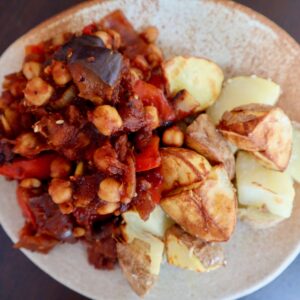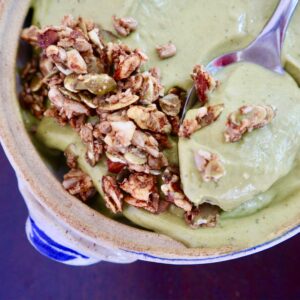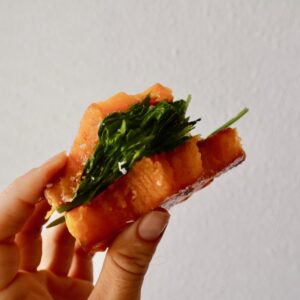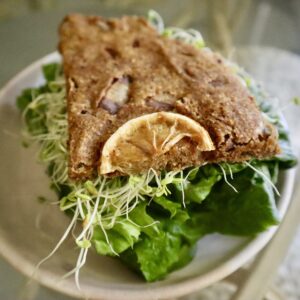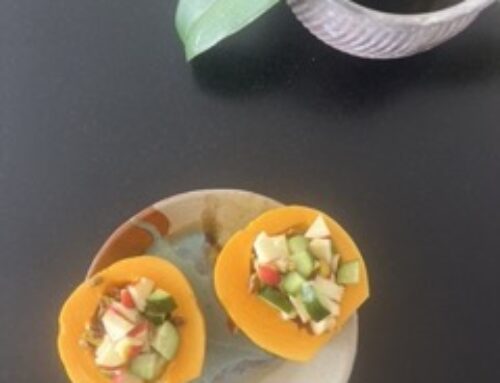The cat’s outta the bag. Let’s talk about the food we should all be eating…
But first. To be clear: this isn’t about shame. This isn’t about guilt. This isn’t about getting it right or not. This isn’t about anything that comes to mind when we hear (or read) the word: should. This is about food the body loves, absorbs well and digests in order to provide YOU with ultimate immunity and ultimately, more positive stable emotions.
So let’s get into it:
Foods EVERY BODY needs & Benefits from:
Fats: olives, avocado, coconut, tahini, hemp
*not from oils but from whole food sources. Why? Think about it this way: To get the recommended amount of omega 3’s from olive oil would require that you consume 1 cup of oil a day which equals 1900 calories. That’s most people’s entire daily allowance. Oil has a quirky way of interfering with glucose metabolism so if you eat a lot of fat and also consume foods containing glucose (fruits, vegetables, carbohydrates etc) this competition slows down your flow of blood. Why isn’t this a good thing? Well. Slower blood flow increases cardiovascular diseases and increases inflammation. No bueno. So eat whole unprocessed fat sources with fiber intact so you at least reap the reward of added fats while contributing to improved digestion. Leave the oils for moisturizing your skin.
Carbohydrates: oats, brown rice, quinoa, white potatoes – yellow, red, russet, sweet potatoes – yams, Okinawan, winter squashes, FRUIT: bananas, apples, dates, apples, pears, oranges, berries, pineapple etc. VEGETABLES: leafy greens, brassicas – broccoli, cauliflower, Brussel sprouts, carrots, beets and herbs like parsley, basil, cilantro & dill.
*our carb phobic society is causing MAJOR distress and unsustainable outcomes. Can you see why? The list of carbohydrates comprises the gamut of nutritious foods which also contain antioxidants, fiber and countless vitamins and minerals. The issue with carbohydrates has never been about the carbs themselves but the ways in which we consume them. Think about it: Pasta Alfredo, Chili Cheese Fries, Peanut Butter and Jelly Sandwiches etc. Combing a lot of fat with a lot of starch and a lot of sugar is a catastrophe for our digestive tract. Add a bunch of meat and dairy to the mix and we’re just plain sick, constipated, diarrhea bound and breaking out – the list goes. There’s no real healthy away around the unconscious ways we’ve been consuming carbohydrates other than to become more conscious of our body’s chemistry and physiology. I promise there are amazing alternatives and our palates are trainable.
Protein: edamame, tempeh, tofu, beans – black, white, kidney, chickpeas, lentils – brown, green, red, pea protein
*eat protein but for god’s sake, it’s not the holy grail. There’s protein in most foods even bananas (1.3g) and broccoli (2.5 g not to mention kale which has 2.9 g per cup) plus fiber to boot. Eat it, don’t obsess about it.
Supplements: psyllium husk, flaxseed, herbs, vitamins: b12, K2, D3, magnesium
*most bodies are deficient in magnesium, k2 and d3. It is what it is. Every body requires b12 and since b12 comes from bacteria there is absolutely zero requirement that we obtain that b12 from animals. Magnesium fights inflammation. D3 boosts immunity. K2 contributes to bone metabolism. Psyllium and Flax are amazing sources of fiber if you know you’re not getting up to 30 grams a day (plus psyllium has been shown to improve autoimmune conditions so please heed this advice if that at all resonates – do your research first!)
Calorie Density – What it is and Why it’s important
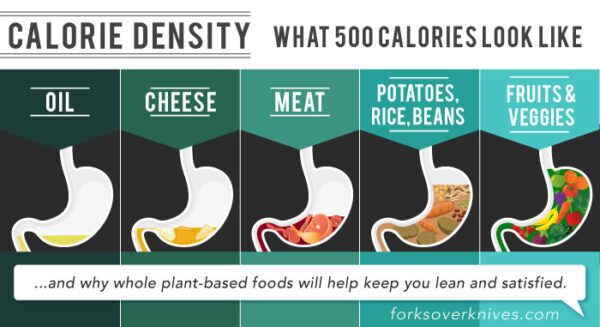
Dillan speaks about Vegan Health – Calorie Density & Metabolism “stop counting calories” It’s a VERY valuable watch for those interested in managing their weight and relationship to food
The basic tenant of calorie density is eating foods that are lower in calories and higher in volume. Caloric Density is simply the measure of how many calories are in a given weight of food. So when I ask if you’re full enough – I’m literally wondering if your belly is full of food or if it’s hungry to be filled. Much of the reason we over-consume food is because we can’t consume enough to actually fill our stomach UNLESS we consume foods that have lower caloric density and a higher amount of food volume. Read that again. We’re hungry to be filled. Our stomachs can hold 1 liter of food. When we consume a lot of food with high caloric density (oily foods, meat, cheese, cheezits, doritos etc) we eat beyond our caloric requirements and end up gaining weight without filling our stomachs. Not to mention, packaged and processed non-foods like chips and most commercial crackers are SO refined (aka broken down into small tiny particles bound by salt, sugar and fat that consuming them spikes our blood sugar – insulin – so rapidly that our bodies struggle to maintain balance which is where diabetes comes in). Sounds so unsatisfying, no? Like – I have all this space wouldn’t it be nice to fill it? How inefficient….
Leptin & Ghrelin
Leptin is our fullness/satiety hormone which is secreted in our fat cells while Ghrelin is our hunger hormone and is secreted in our stomach lining. When the tummy is empty it sends signals to the brain that a meal is in order. Leptin controls appetite while Ghrelin stimulates our appetite and BOTH respond to how well fed we are. Assaulting our hormones with processed foods over time gives the brain very mixed signals. A Whole Food Plant Based Diet results in less fat storage but whether or not you consume animal foods or plant foods, our bodies naturally have weight regulating mechanisms that work HARD to keep us in homeostasis (balance). “Both leptin and ghrelin are peripheral signals with central effects.” Aka, our hormones are secreted around and throughout our bodies but affect our brain – which is central.
Leptin is made by fat and then secreted into the circulatory system and then travels to the hypothalamus. Leptin tells the brain we have enough fat. Ghrelin tells the brain our stomach is empty. The more fat the more leptin. The less fat, the less leptin, the hungrier we are. If you want to lose weight – you want MORE leptin (but) HOLD THE DOOR.
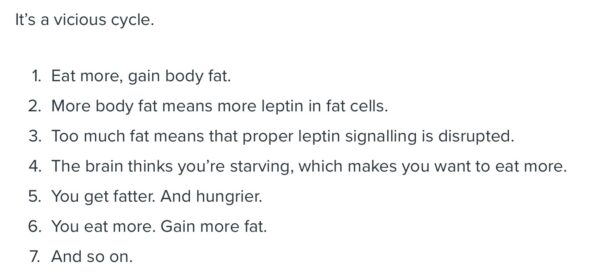
Just because someone has high levels of leptin doesn’t mean that they’re not overweight, in fact, quite the contrary. Leptin is the thing you can grab when you’re looking in the mirror and dissatisfied with your image. I hate to say it. This is because after years of clobbering our bodies with ultra processed foods and binge-like behaviors leptin resistance ensues. The brain stops listening and in a lot of cases, the brain takes revenge by signaling to you that you’re hungry when you may be fat (please know I’m not speaking directly to you). Basically, obesity is dangerous because the brain stops receiving signals that it’s full and actually make you hungrier (and thus, creates a self perpetuating cycle). It’s sad, tbh. This is why we should avoid fat shaming at all costs. Those who struggle with obesity are literally feeding an unconscious beast. Additionally, obese or not, losing the fat battle is defeating but winning is more than possible.
So what does eating plant foods have to do with anything – especially our hunger hormones? Can you master these hormones, lose weight AND keep it off?
Well, it’s been shown that Vegan lifestyles (I say “lifestyle”carefully because Veganism isn’t as much a diet per say as it doesn’t require portioning your food, eliminating, reducing, rationing macronutrients or suggest in any way that you go into a caloric deficit which is one of the reason I love it so much – e’hem, tangent) enhance insulin secretion and regulate blood sugar – likely due to the presence of a lot of beneficial dietary fiber. One of the best, and since I’m biased, *only ways to build a healthy relationship with these hormones is by initiating a diet overhaul. If you know that you pound your body with ultra processed and refined foods then it will make the process easier. Honesty is KEY. Simply go back to the top of this post where I mindfully guide you toward choosing foods that fuel your hormones as opposed to trick them.
Other helpful practices that keep leptin & Ghrelin intact and your brain happy include:
- eating enough: fill your stomach with starchy and non starchy vegetables (potatoes and broccoli for example), fruit and whole steamed grains like brown rice and a small amount of seeds.
- eat fiber and reduce fat. This does not mean “eat fat free” but to keep in mind that high fat, low carbohydrate diet plans result in lower circulating leptin. Additionally, a low fat high carbohydrate (see list of whole unprocessed carbs I list above) has an *inhibitory effect on Ghrelin levels and results in weight loss without an increase in plasma Ghrelin levels. Aka, choose foods that are naturally low in fat and eat an abundance of them.
- exercise! Movement increases leptin.
Did I say ONLY? What I meant by only was *in addition to: therapy. Changing our dietary ways sounds really easy and while we all likely aspire to living in healthy, happy, mobile, joyful bodies – the road to getting there is filled with set backs and emotional blocks – we’re hardwired to avoid pain and sometimes that’s just what therapy is. Painful. It’s also transformative. Weight is a weighty issue and like Set Point Theory teaches us:
… our bodies have a preset weight baseline hardwired into our DNA. According to this theory, our weight and how much it changes from that set point might be limited. The theory says some of us have higher weight set points than others and our bodies fight to stay within these ranges.
We’re kind*of sort*of doomed*to return to that cozy place the body loves to hang out in….Just kidding. We can absolutely achieve long term sustainable weight loss and manage it by addressing positive changes with food consumption and learning emotional regulation!! That’s where I come in.
Please feel free to subscribe,
Join my Quarterly Body Reset,
Become a Member in my Therapeutic Eating Journey (includes the cost of all resets),
Purchase my Therapeutic Eating Program
And, OR, follow me on Instagram
XO
Katie
- Lima Beans with Parsley and Air Fried Potatoes
- Kelp Noodles with Kimchee & Papaya Seed Dressing
- Ratatouille & Air Fried Potatoes
- Banana and superfood greens Nice Cream with Grain Free Granola
- Butternut Squash sandwich buns with greens
- Flatbread with leafy greens, sprouts and cashew cream cheese




